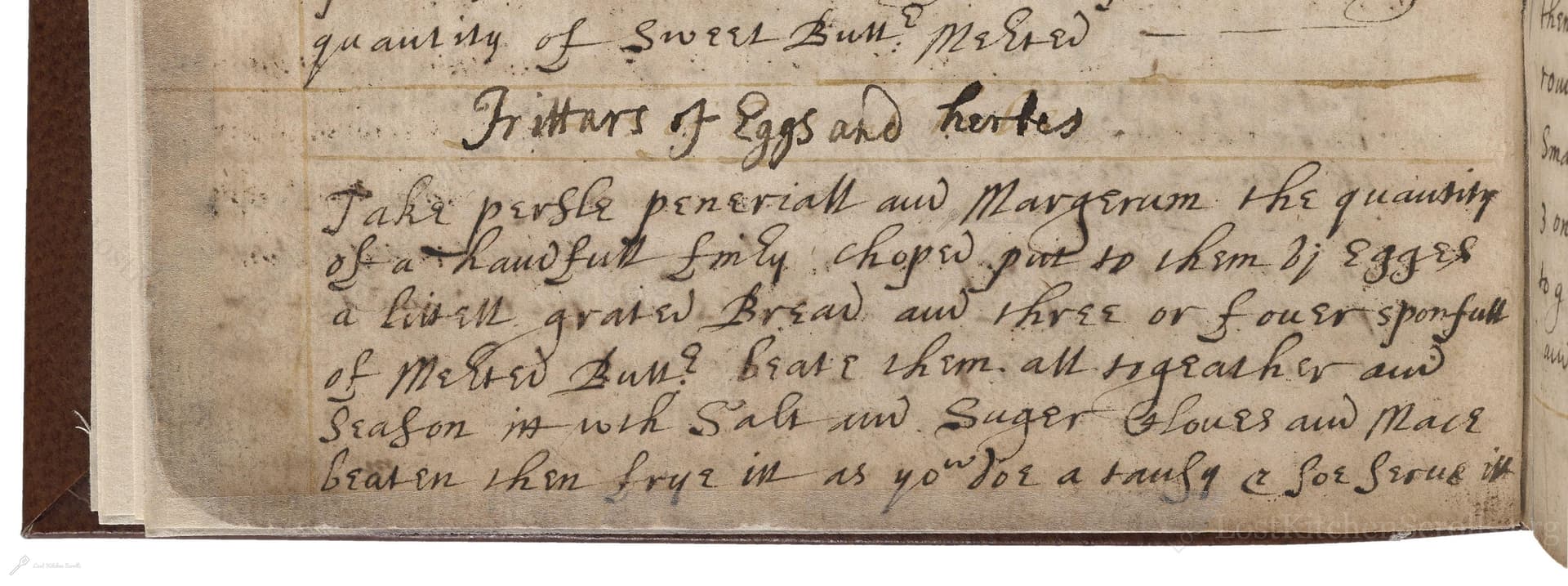
Frittars Of Eggs And Herbes
"Take persle peneriall and Margerum the quantity of a handfull finely choped put to them ij Eggs a little grated Bread and three or fouer sponfull of Melkd Butter beate them all togeather and Season it with Salt and Suger Cloves and Mace beaten then frye it as you doe a tansy & soe serve it."
Note on the Original Text
The original recipe is a typical example of late 17th-century handwritten cookery: it relies on brief, functional instructions meant for experienced hands. Quantities are often approximate—'the quantity of a handfull,' 'three or fouer sponfull,' 'a little'—and specific times or temperatures are absent. Spelling reflects the norms of the period: 'Margerum' for marjoram, 'persle' for parsley, and 'peneriall' for pennyroyal. The direction 'frye it as you doe a tansy' assumes the cook's familiarity with contemporary recipes, offering guidance by analogy rather than explicit instruction.

Title
Cookery book of Lettice Pudsey, Seisdon, Staffordshire (1675)
You can also click the book image above to peruse the original tome
Writer
Lettice Pudsey
Era
1675
Publisher
Unknown
Background
Step into the 17th-century kitchen with Lettice Pudsey's delightful collection of recipes, where flavors, creativity, and tradition mingle to create a feast fit for Restoration-era tables. Expect a medley of hearty English fare, intriguing ingredient combinations, and a pinch of culinary wisdom from a bygone age.
Kindly made available by
Folger Shakespeare Library
This recipe originates from the handwritten cookbook of Lettice Pudsey, compiled around 1675. In this period, households kept detailed records of culinary preparations, merging practical cookery with local herbal knowledge. Dishes like 'frittars' (fritters or omelettes) were popular both for their simplicity and their adaptability, allowing cooks to make the most of seasonal herbs and eggs from the household flock. Seventeenth-century English cuisine celebrated the interplay of sweet and savory, and the inclusion of spices like cloves and mace alongside sugar shows both the increasing availability of exotic ingredients and a taste for aromatic complexity. Recipes were often written as brief reminders for skilled cooks, not as step-by-step guides—reflecting an era in which culinary literacy was assumed among household staff or gentlewomen.

In Lettice Pudsey's time, these frittars would have been mixed in earthenware or wooden bowls, whisked with a forked stick or a wooden spoon. Herbs were chopped using a small, sharp knife—sometimes a two-handled mezzaluna-type chopper. Frying would take place over a wood or coal-fired hearth, in a heavy iron or copper pan, with butter or clarified fat used for cooking. Cooks would judge heat and doneness by sight, sound, and scent, without the convenience of thermometers or timers.
Prep Time
10 mins
Cook Time
8 mins
Servings
2
We've done our best to adapt this historical recipe for modern kitchens, but some details may still need refinement. We warmly welcome feedback from fellow cooks and culinary historians — your insights support the entire community!
Ingredients
- 0.5 oz fresh parsley (finely chopped)
- 0.5 oz fresh pennyroyal leaves (or substitute mint, finely chopped)
- 0.5 oz fresh marjoram (finely chopped)
- 2 medium eggs
- 1 oz breadcrumbs (preferably fresh)
- 1/4 cup whole milk or melted butter (or a mix)
- Pinch of salt
- 1/4 tsp sugar
- 1/8 tsp ground cloves
- 1/8 tsp ground mace
- Butter or oil for frying
Instructions
- To prepare these delightful 17th-century 'Frittars of Eggs and Herbes,' start by finely chopping a generous handful of fresh parsley, pennyroyal (or substitute with mint if pennyroyal is unavailable), and marjoram—about 0.5 ounces each.
- In a mixing bowl, beat together 2 medium eggs, 1 ounce of fresh breadcrumbs, and 1/4 cup of whole milk or melted butter (or a mixture of both).
- Add the chopped herbs to the mix, and season with a pinch each of salt, sugar, ground cloves, and ground mace.
- Whisk until well combinned.
- Heat a little butter in a nonstick frying pan over medium heat.
- Pour in the mixture, cooking gently as you would an omelette or a thin frittata (similarly to a 'tansy,' a traditional herb omelette of the era), turning or folding once golden on the bottom.
- Serve warm, perhaps dusted with a little extra sugar, for a sweet-savory treat.
Estimated Calories
180 per serving
Cooking Estimates
It takes about 10 minutes to chop the herbs and prepare the batter, and around 8 minutes to cook the frittars in a pan. Each frittar contains about 180 calories and the recipe makes 2 servings.
As noted above, we have made our best effort to translate and adapt this historical recipe for modern kitchens, taking into account ingredients nowadays, cooking techniques, measurements, and so on. However, historical recipes often contain assumptions that require interpretation.
We'd love for anyone to help improve these adaptations. Community contributions are highly welcome. If you have suggestions, corrections, or cooking tips based on your experience with this recipe, please share them below.
Join the Discussion
Rate This Recipe
Dietary Preference
Main Ingredients
Culinary Technique
Occasions

Den Bockfisch In Einer Fleisch Suppen Zu Kochen
This recipe hails from a German manuscript cookbook compiled in 1696, a time whe...

Die Grieß Nudlen Zumachen
This recipe comes from a rather mysterious manuscript cookbook, penned anonymous...

Ein Boudain
This recipe comes from an anonymous German-language manuscript cookbook from 169...

Ein Gesaltzen Citroni
This recipe, dating from 1696, comes from an extensive anonymous German cookbook...
Browse our complete collection of time-honored recipes



